Mastering the Minimalist Home Office: Design Ideas for Focus and Productivity
Creating a dedicated space where you can think clearly, work efficiently, and achieve your goals doesn’t require an abundance of items. In fact, often, less is more. A well-designed minimalist home office is a powerful tool for enhancing focus, reducing stress, and maintaining a tidy environment. It’s not just about aesthetic appeal; it’s profoundly about optimizing your workspace for maximum personal effectiveness and well-being.
This comprehensive guide provides everything you need to establish your own serene and productive minimalist workspace. We’ll delve into intelligent layout strategies, ingenious storage solutions, and tasteful decorating methods that ensure your office remains clutter-free and inspiring. From exploring diverse design styles and selecting the perfect color palette to showcasing real-world setups you can effortlessly adapt, we cover all the essentials.
If your aim is to cultivate a calm, clean, and highly functional workspace that genuinely supports your best work, you’ve arrived at the perfect resource. Join us as we transform your home office into a sanctuary of productivity.
What is a Minimalist Home Office?
At its core, a minimalist home office is built on the philosophy of simplicity and intentionality. It’s about meticulously removing anything that doesn’t serve a purpose or bring joy, retaining only the essentials that contribute to a productive and calm environment. This means embracing clean, uncluttered surfaces, a soothing palette of neutral colors, and furniture pieces chosen for their practical utility and refined form.
Most minimalist offices gravitate towards natural and durable materials such as light-toned wood, sleek metal, or transparent glass. These materials contribute to an airy, light-filled atmosphere and are inherently easy to maintain, reinforcing the clean aesthetic. Popular design styles that perfectly align with minimalist principles include Scandinavian, known for its warmth and functionality; Industrial, with its raw textures and utilitarian elegance; Japandi, a harmonious blend of Japanese and Scandinavian aesthetics; and Modern Farmhouse, which offers a contemporary twist on rustic charm. All these styles prioritize practical design, calm color schemes, and crisp, uncluttered lines, making them ideal foundations for your minimalist workspace.
Planning Your Minimalist Workspace
The journey to your ideal minimalist home office begins with strategic planning. Start by identifying a location within your home that best suits your daily routine and concentration needs. This could be a dedicated spare room, a discreet corner of your bedroom, a clever nook tucked under a staircase, or an elevated mezzanine area. The key is to choose a spot where you can minimize distractions and maximize focus.
Once your location is chosen, precise measurement of the space is crucial. You’ll need ample room for your desk, an ergonomic chair, and sufficient breathing space to move comfortably. Don’t overlook the importance of lighting. Natural light is invaluable for boosting alertness, mood, and overall productivity, so positioning your desk near a window is often ideal. For areas with limited natural light or for evening work, supplemental lighting is essential. Consider stylish yet functional desk lamps for focused task lighting and wall sconces or recessed lighting to provide ambient illumination without adding visual bulk.
Finally, consider ergonomics from the outset. Your chair should provide excellent lumbar support, and your monitor should be at eye level to prevent strain. A minimalist approach doesn’t mean sacrificing comfort or health; rather, it means choosing high-quality, supportive pieces that are designed for longevity and well-being.
Clean and Functional Desks Idea
The desk is the centerpiece of any home office, and in a minimalist setting, it must be both unobtrusive and highly functional. Minimalist desks come in a variety of innovative forms, each designed to optimize space and maintain a clean aesthetic.
- Wall-mounted desks are excellent for maximizing floor space and creating an impression of lightness and openness. They can be custom-built to fit specific dimensions or purchased as floating shelves that double as a workspace. These are particularly effective in smaller rooms or multi-functional spaces.
- L-shaped desks are ideal if your work requires a larger surface area or if you need to accommodate multiple tasks, such as a computer setup on one side and a writing or drawing area on the other. Look for designs with sleek lines and integrated storage to prevent clutter.
- Built-in desks offer a seamless and integrated look, especially effective in shared spaces or if you desire a permanent fixture that blends with your home’s architecture. They can be customized with hidden compartments and cable management systems for ultimate tidiness.
When selecting your desk, prioritize designs that incorporate hidden drawers, discreet shelving, or integrated cable management. These features provide essential storage without disrupting the minimalist aesthetic, keeping your workspace streamlined and free from visual noise. Materials like light wood, white laminate, or even clear glass can enhance the feeling of space and light.
Storage That Stays Out of Sight
A hallmark of a truly minimalist office is its ability to conceal clutter. Effective storage solutions are designed to be discreet, keeping all your work essentials organized and out of view. This creates a calm visual environment conducive to concentration.
- Integrated desk storage: Many minimalist desks come with built-in drawers or compartments, perfect for pens, notebooks, and other small items. This keeps your desktop clear and focused.
- Floating shelves: Simple, clean-lined floating shelves are excellent for housing books, files, or decorative items without occupying floor space. Arrange them symmetrically for a balanced look.
- Storage benches or sideboards: If space allows, a low-profile storage bench or a minimalist sideboard can offer substantial hidden storage for larger items, doubling as extra seating or a surface.
- Smart cable management: One of the biggest culprits of visual clutter is tangled wires. Invest in cable clips, trays, or sleeves to keep all cords neatly organized and out of sight, preventing a messy floor and a chaotic feel.
- Vertical storage units: Tall, slim cabinets or bookcases with doors can utilize vertical space effectively without making the room feel crowded. Opt for closed storage to maintain the minimalist aesthetic.
By thoughtfully integrating these storage solutions, you can ensure that everything has a designated place, making it easy to keep your office tidy and functional.
The Perfect Minimalist Color Palette

The foundation of a minimalist color palette is often a calming, neutral base. Begin with shades of pure white, soft off-white, cream, or a light beige. These foundational colors reflect light, making the space feel larger and airier, and they serve as a perfect canvas for layering. To add depth and sophistication, introduce complementary neutral tones such as various shades of grey, elegant black, deep navy, or the natural warmth of wood tones. These colors work harmoniously together, avoiding visual competition and fostering an atmosphere of tranquility and focus.
If you wish to infuse a hint of personality, use accent colors judiciously and with intention. A single, well-chosen item, such as a comfortable forest green ergonomic chair, a sleek copper desk lamp, or a vibrant piece of abstract art, can introduce a pop of color and character without overwhelming the minimalist harmony. The key is restraint and thoughtful placement, ensuring that any accent color enhances rather than detracts from the overall calm and clean aesthetic of your workspace.
Decor That Enhances, Not Distracts
Minimalism doesn’t equate to an absence of decor; rather, it encourages a mindful approach to embellishment. Choose a select few items that genuinely contribute to comfort, provide visual interest, or offer a touch of personal expression, ensuring they align with the overall serene environment.
- Potted plants: Introduce a touch of nature with a simple potted plant like a snake plant, ZZ plant, or a small succulent. Plants not only add freshness and life but can also improve air quality and subtly connect you to the outdoors, enhancing well-being.
- Art prints: One or two carefully selected pieces of art can serve as a focal point, adding personality and sophistication without clutter. Opt for abstract art, minimalist landscapes, or graphic prints in muted tones that complement your color palette.
- Textural elements: Incorporate texture to add warmth and depth to your space. A soft wool rug underfoot, a comfortable throw draped over your chair, or subtly textured cushions can make the office feel more inviting and less stark.
- Modern lighting: Beyond task lighting, consider modern lighting fixtures that double as decor. Sleek wall sconces, subtle LED strips (especially under shelves or desks), or slim, architecturally interesting desk lamps can elevate the space both functionally and aesthetically.
- Personalized items (sparingly): A single framed photo of loved ones or a meaningful keepsake can add a personal touch without creating visual noise. The goal is to curate a space that feels deeply personal yet remains uncluttered.
Each decor piece should have a purpose, whether it’s to inspire, comfort, or simply look beautiful, contributing to a harmonious and distraction-free workspace.
Minimalist Home Office Design Ideas
These minimalist home office ideas are meticulously crafted to prioritize comfort, optimize function, and foster a sense of calm. Whether you’re navigating the confines of a small apartment or simply aspiring to a more organized and serene workspace, you’ll discover adaptable options that cater to your specific needs. Here are ten inspiring minimalist setups you can integrate into your home, ranging from space-saving solutions to elegantly designed shared environments:
1. Floating Desk by the Window
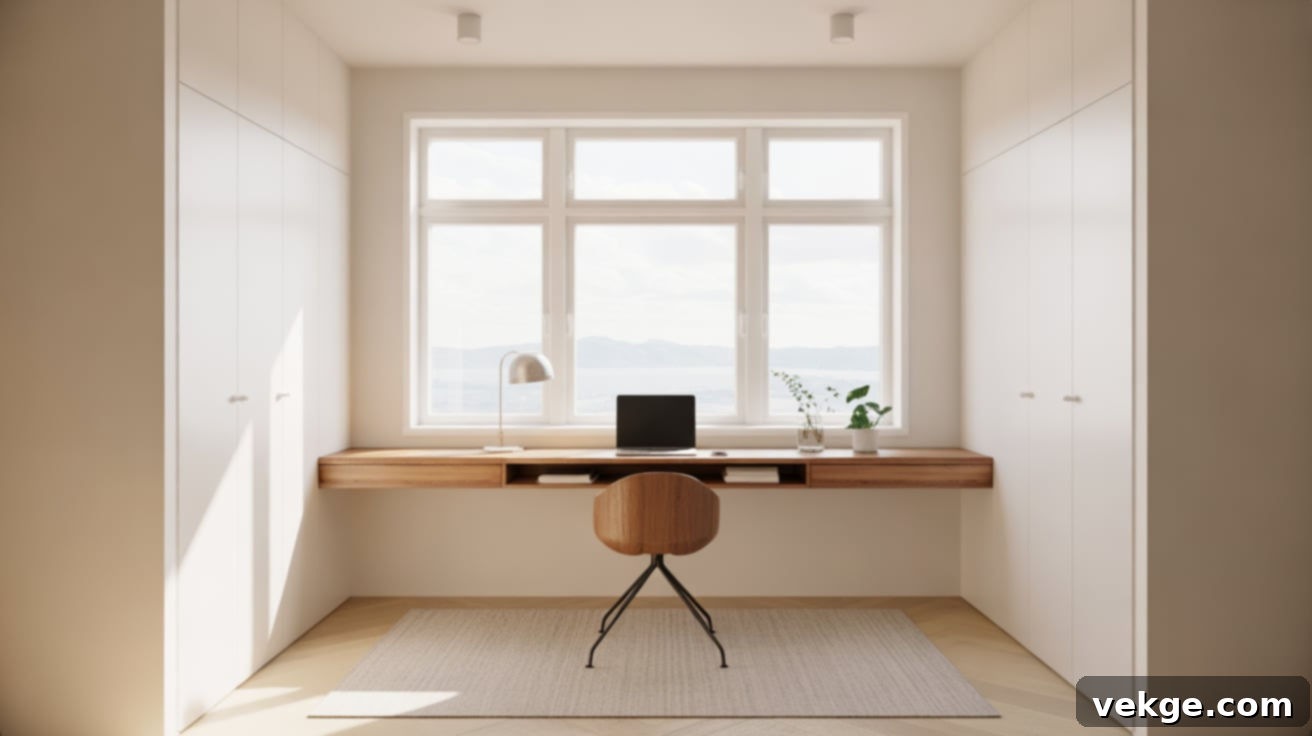
A floating desk is an exceptional choice for maximizing space, particularly in compact living areas. Mounting it directly by a window offers the immense benefit of abundant natural light throughout your workday. This not only helps maintain alertness and focus but also contributes to a more relaxed and positive mood. The design inherently keeps the floor clear, creating an illusion of greater space and making the room feel significantly larger. This setup is perfectly suited for bedrooms, studio apartments, or any small dwelling where every square inch is valuable but comfort and aesthetic appeal remain paramount.
2. Monochrome Black & White Setup
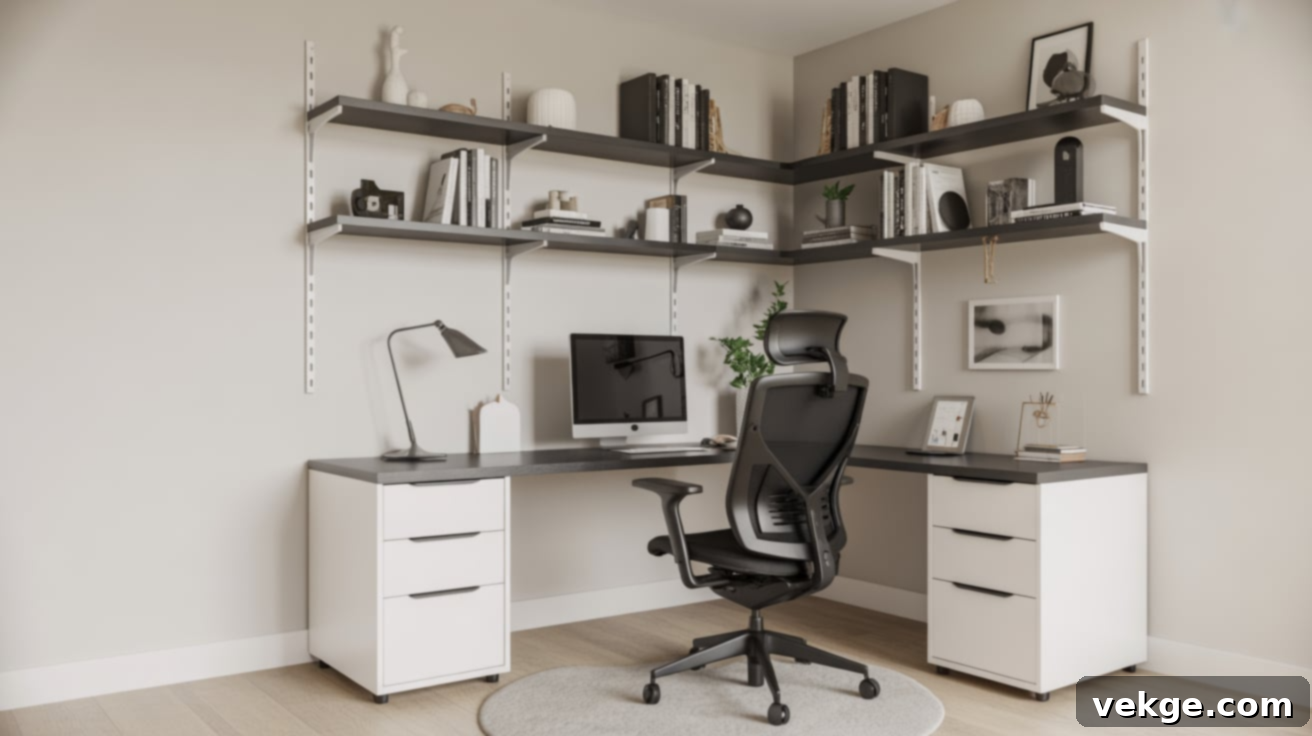
Embracing a monochrome black and white theme instantly creates a sophisticated, clean, and unequivocally simple look. Utilize dark accents, such as a black ergonomic chair or a dark desk, to “ground” the space, providing visual anchors. Complement this with crisp white walls, a white desk surface, or white storage units to ensure the area feels open, bright, and expansive. This stark yet elegant contrast effectively defines and separates your work zone from the rest of the room without introducing any visual noise or distracting elements. Maintain this consistent color scheme across your furniture, accessories, and even tech gadgets for a cohesive, polished, and effortlessly chic minimalist office.
3. Scandi Style with Open Shelves
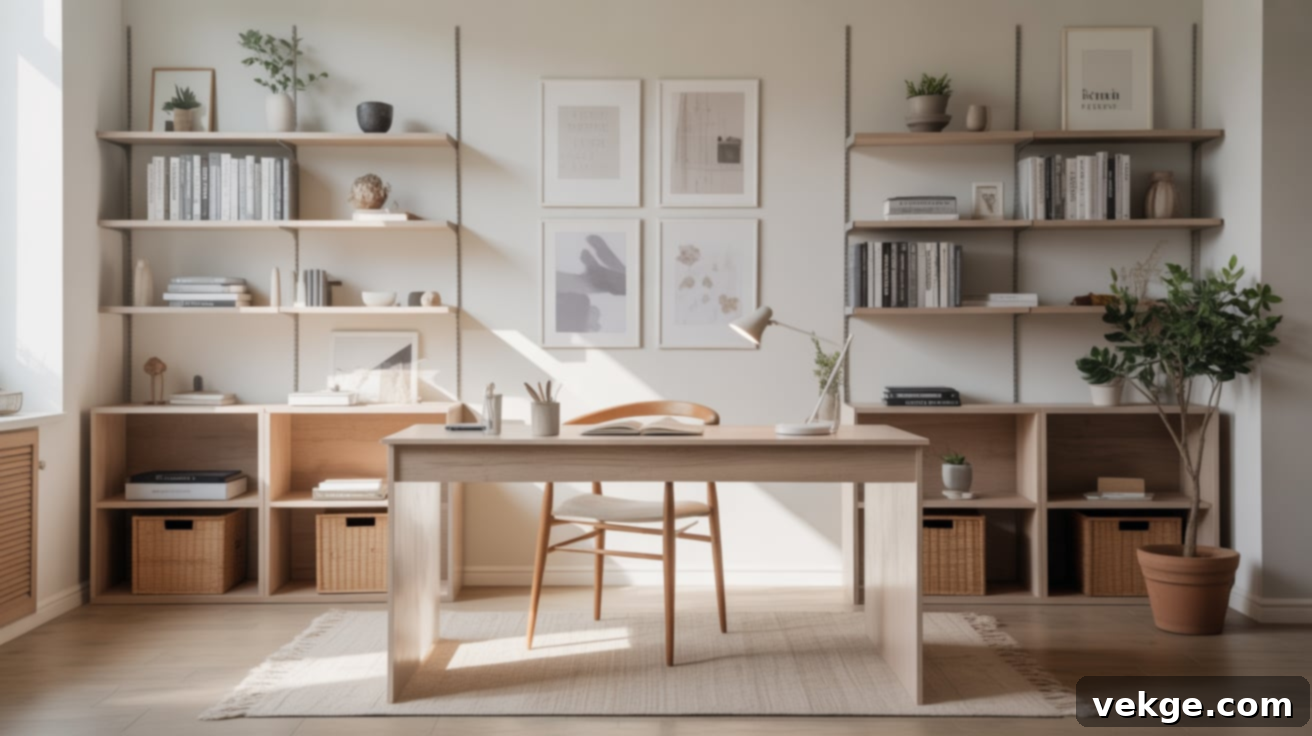
Scandinavian design is globally celebrated for its innate ability to combine calm aesthetics with impeccable functionality and clean lines. To embody this style, pair light-toned woods—think birch, ash, or light oak—with soft, muted white or inviting beige tones for walls and textiles. This combination creates an inherently cozy, welcoming, and airy atmosphere without any hint of clutter. Open shelves, a staple of Scandi design, provide practical storage for your essential work items while also offering opportunities to display a few thoughtfully chosen personal effects, such as a lush green plant, a minimalist ceramic vase, or a framed photograph, adding warmth and personality to the space.
4. Under-the-Stairs Office Nook
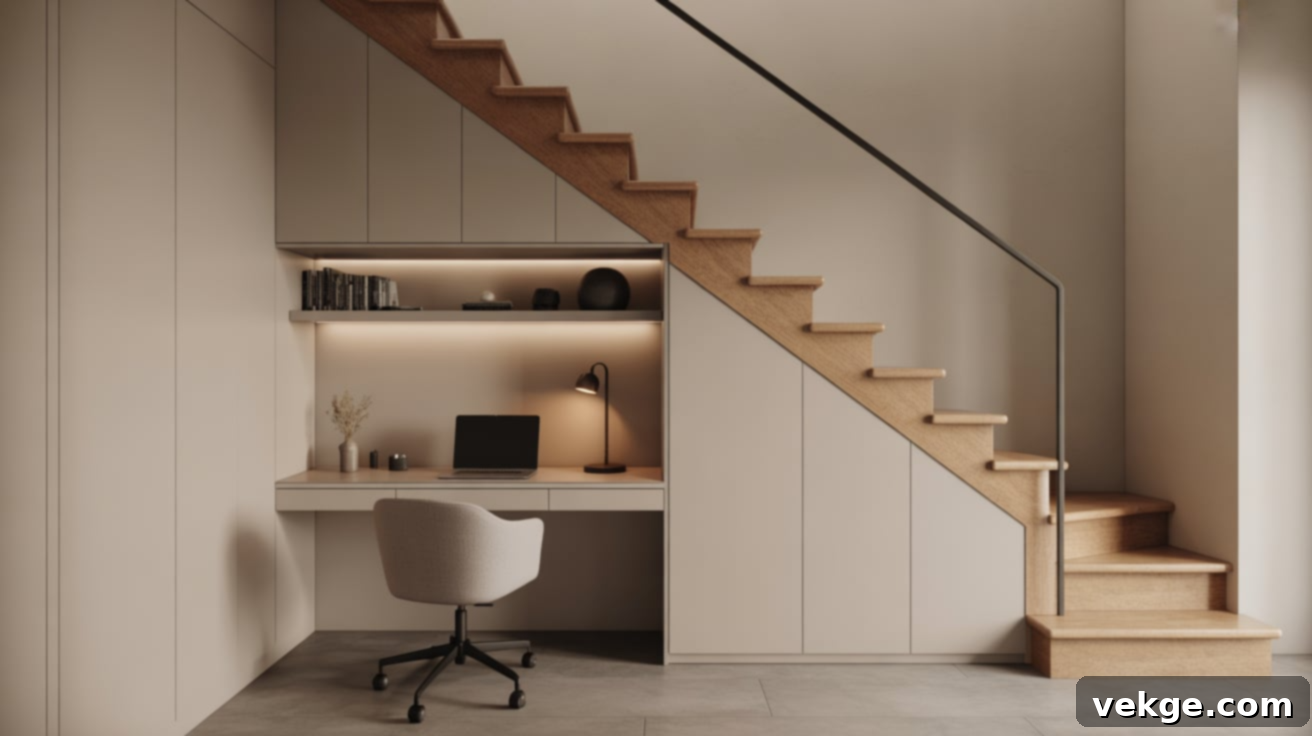
For homes featuring a staircase, the often-overlooked area beneath it presents a golden opportunity for a highly functional and space-efficient office. A custom-built desk that perfectly fits the unique dimensions of the nook, paired with a compact, comfortable chair and a few integrated shelves, can ingeniously transform this formerly unused space into a quiet and secluded workspace. This clever utilization of an unconventional area is a smart way to add significant function to your home without encroaching upon or redesigning another room. To ensure seamless integration, keep the decor exceptionally simple and cohesive with the surrounding home aesthetic, allowing the nook to feel like a natural extension of your living space.
5. Double Desk for Two People
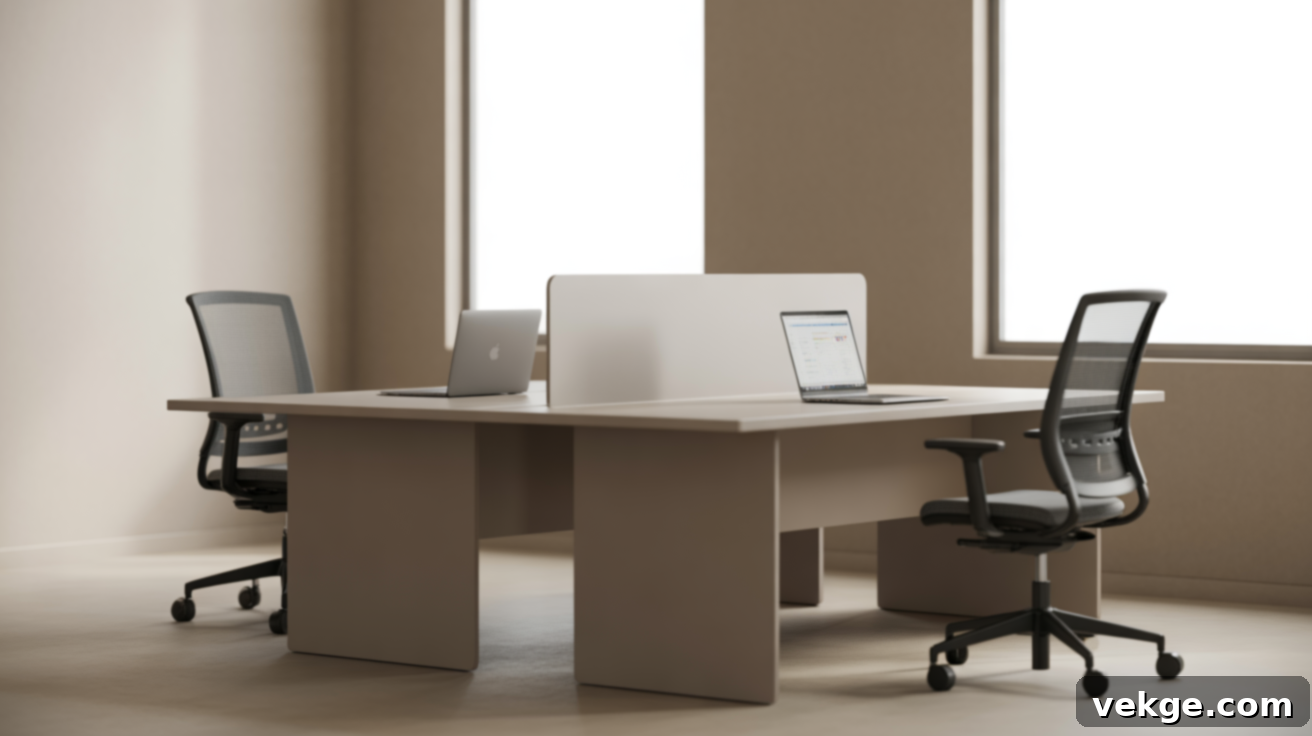
Sharing a workspace doesn’t necessitate compromising on design or organization. A long, expansive desk complemented by two matching ergonomic chairs and mirrored setups on each side creates a harmonious and efficient environment for you and your partner or roommate. This symmetrical approach fosters individual productivity while promoting a sense of shared purpose. Opt for built-in drawers, sleek wall shelves, or even discreet under-desk storage units to keep all work essentials off the floor and out of sight. A shared space thrives when both sides are meticulously maintained, ensuring a balanced, neat, and mutually respectful working environment.
6. Glass Desk in a Bright Corner
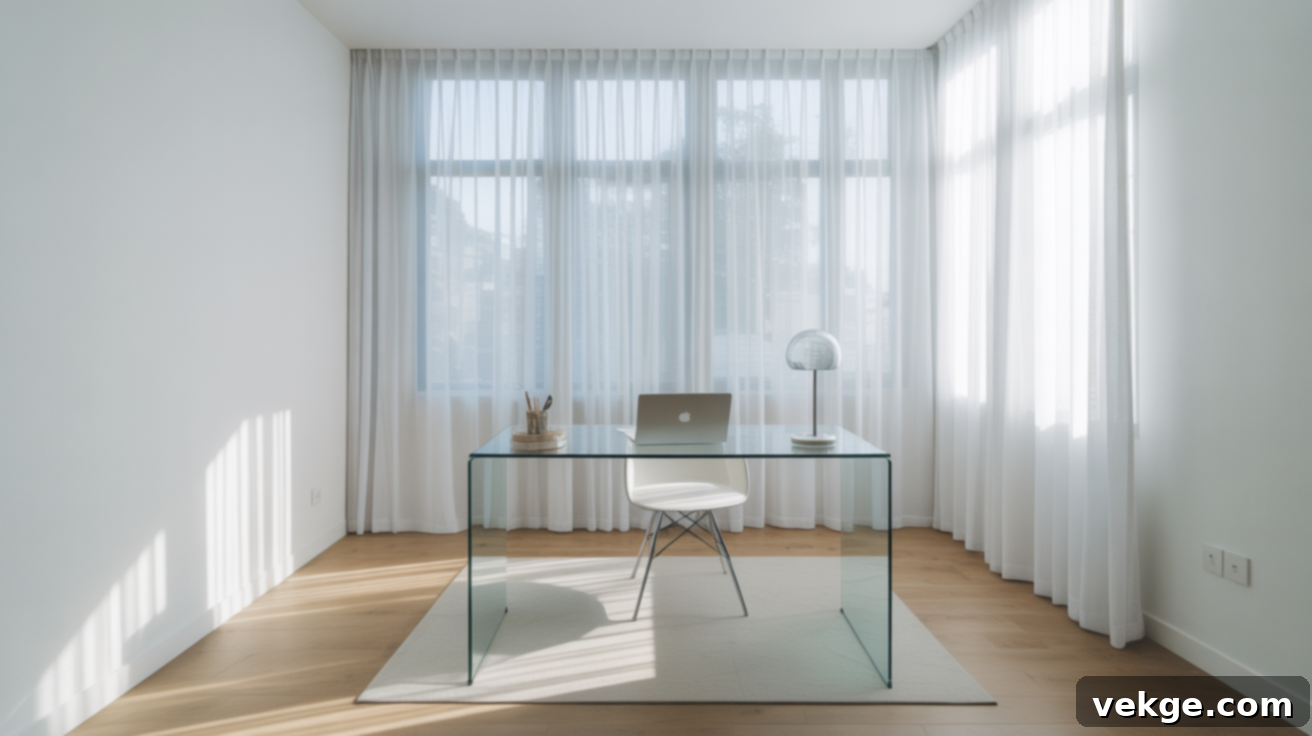
A glass desk is an exceptional choice for minimalist offices, especially in smaller rooms, as its transparent nature reflects light beautifully and creates an illusion of invisibility. This unique quality helps to open up the space, making even the most compact rooms feel significantly more expansive and airy. Pair the glass desk with a simple, understated chair and a soft, neutral color palette to prevent any sense of visual clutter. If you’re fortunate enough to have a bright corner or a window-adjacent spot, this setup maximizes natural light, cultivating an environment where it’s effortless to stay focused and productive without any visual distractions.
7. Neutral Grey Tones with Art Accents
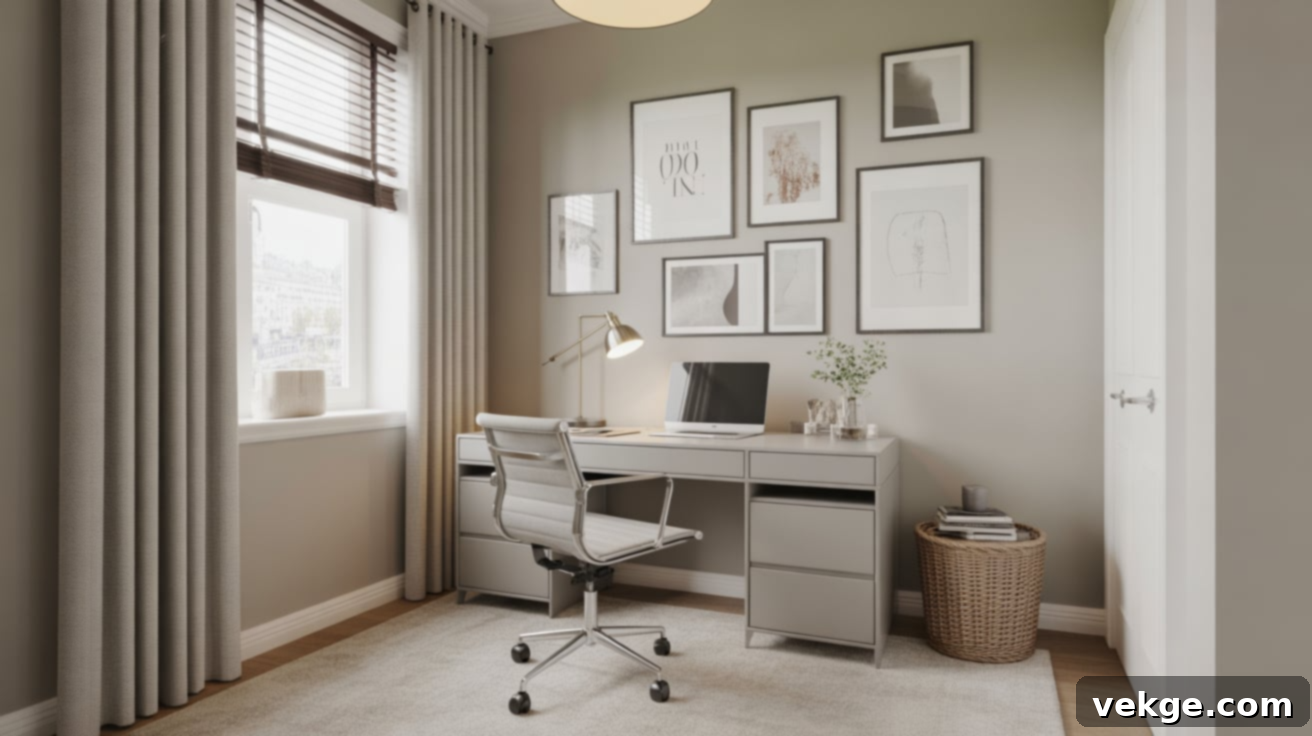
Grey tones, with their inherent softness and steady presence, are perfectly suited for cultivating a calm and sophisticated workspace. They provide a versatile and soothing backdrop that promotes focus without being stark. To infuse character and depth into this serene foundation, introduce a few carefully chosen pieces of simple wall art or framed prints. These accents can add a subtle splash of color or intriguing visual texture without overwhelming the room. Utilize lighter greys for expansive wall surfaces to enhance brightness, and reserve darker charcoal or slate shades for furniture or specific accents to build visual depth, ensuring the room feels layered yet effortlessly balanced.
8. All-White Setup with Natural Wood Highlights
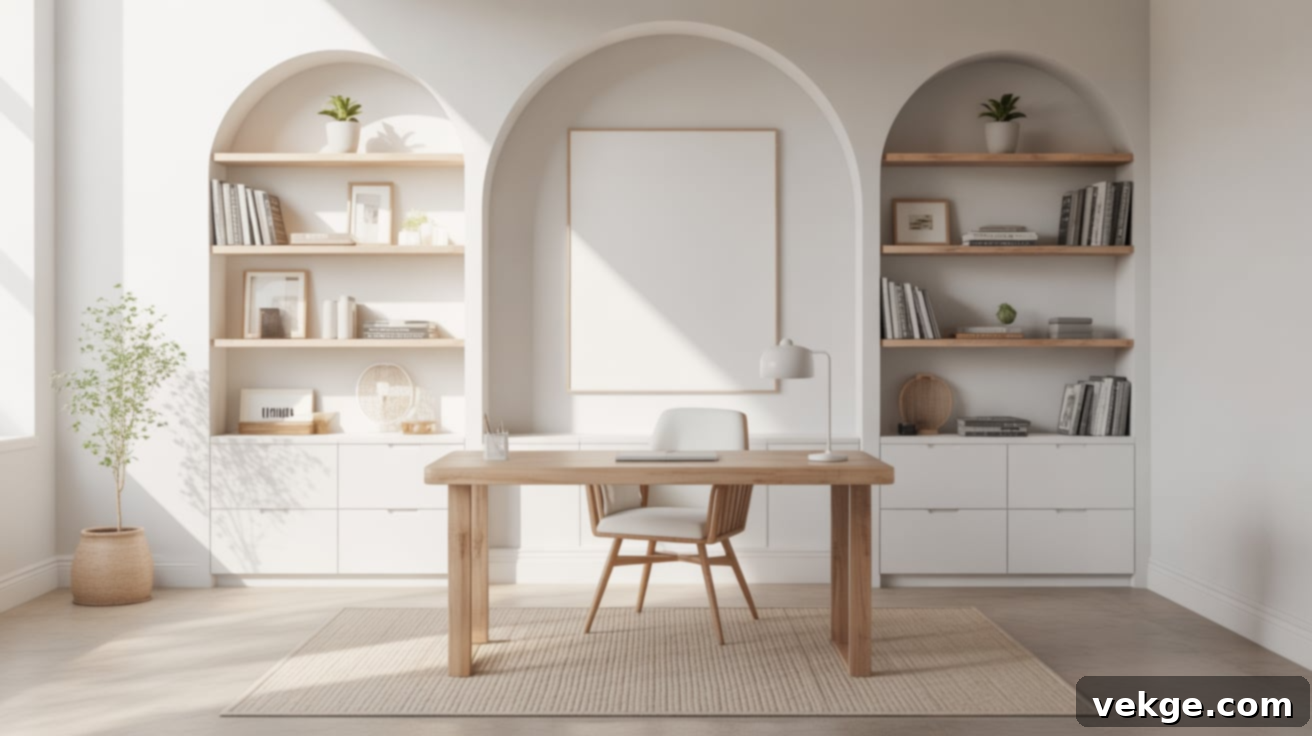
An entirely white space inherently feels fresh, clean, and incredibly open, making it a classic choice for a minimalist aesthetic. However, by strategically introducing elements of natural wood, you can instantly infuse the space with much-needed warmth, organic texture, and a touch of biophilic design. Consider incorporating a sleek wooden desk, open shelving crafted from light-toned wood, or chairs featuring elegant wood legs. These elements soften the crispness of the white, creating a more inviting and less sterile environment. This particular setup excels in smaller rooms or in shared living areas where the office needs to seamlessly blend into the surrounding decor, maintaining a sense of quiet sophistication.
9. Shared Desk with Matching Chairs
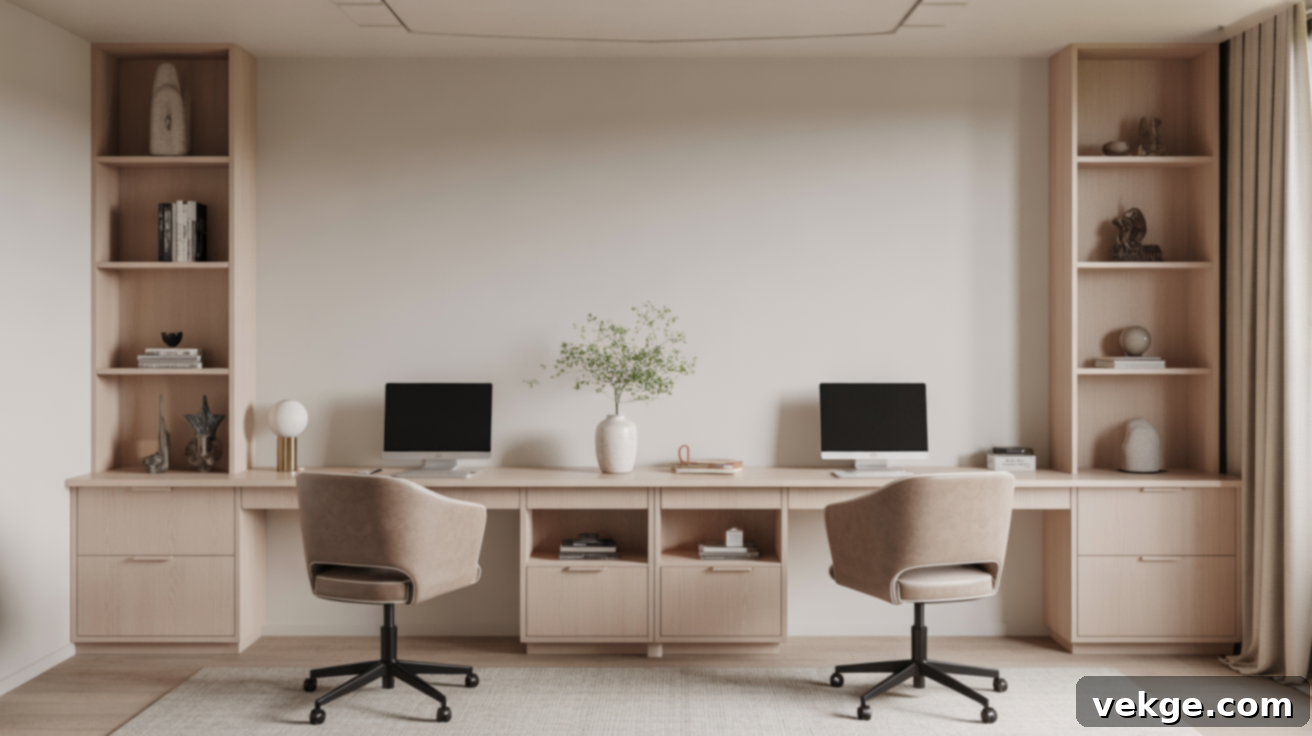
For two individuals collaborating or simply sharing a common work area, maintaining visual harmony is paramount for a peaceful and productive environment. Opting for matching chairs and a unified desk style is a simple yet incredibly effective strategy to make the entire room feel meticulously organized and aesthetically balanced. This consistency prevents the setup from appearing cluttered or visually lopsided, promoting an atmosphere of calm efficiency. To further enhance this sense of order, stick to a palette of neutral colors for all furniture and accessories, and choose low-profile pieces that don’t dominate the space. The result is an open, tranquil, and equally comfortable workspace for both users.
10. Minimalist Office with a Cozy Daybed
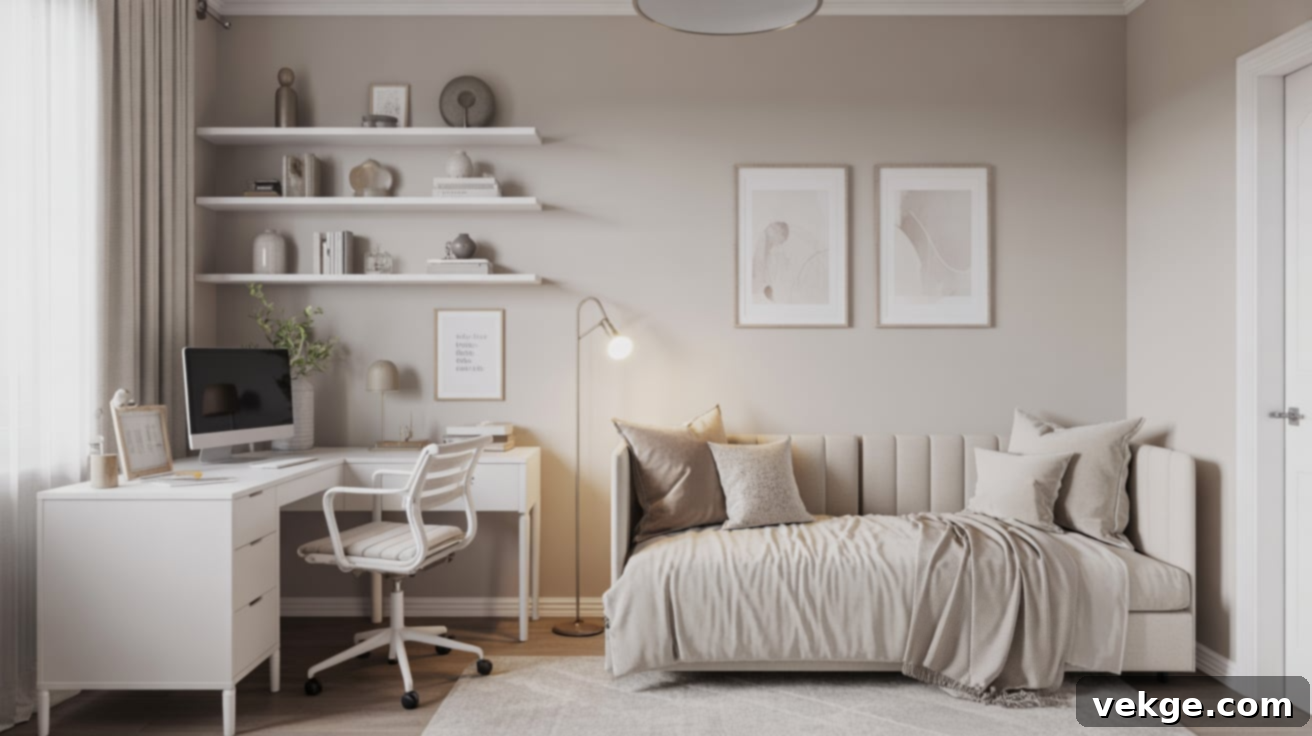
This innovative design concept is best suited for a spare room, a spacious studio apartment, or any area where you desire a dedicated workspace that also offers a comfortable spot for relaxation or contemplation. A daybed serves a dual purpose: it provides an inviting break spot for moments of rest or reflection, and it can effortlessly double as additional seating for guests. To maintain the minimalist integrity of the office, ensure the rest of the workspace remains impeccably clean and uncluttered. Limit decorative items to a bare minimum, and select neutral bedding and pillows for the daybed to ensure it seamlessly complements your streamlined workspace, creating a harmonious and multi-functional room.
Small Space, Big Ideas: Tips for Compact Rooms
Even the most modest of rooms can be transformed into a highly functional and inspiring minimalist home office with a few strategic choices. The fundamental principle is to remain laser-focused on your essential needs and to utilize every inch of your available space with intelligent precision. A compact office doesn’t have to feel cramped; the secret lies in maintaining a clean layout and selecting lightweight, unobtrusive furniture.
Carefully consider how each item integrates into your daily routine. In a small room, wall space becomes just as valuable as floor space, offering ample opportunities for vertical storage and creative solutions. Prioritize multi-functional pieces and visual tricks that expand the perception of space.
Here are some essential tips to keep your compact setup clean, efficient, and comfortable:
- Narrow or fold-down desks: Opt for a sleek, narrow desk that takes up minimal floor space, or consider a fold-down wall desk that can be tucked away when not in use, instantly reclaiming valuable room.
- Vertical storage: Maximize your vertical real estate with shelves positioned directly above or beside your work area. Floating shelves are perfect for keeping supplies organized and easily accessible without adding bulk.
- Compact seating: Choose a foldable chair or a slim, backless stool that can be effortlessly stored under your desk or tucked into a corner when not needed, freeing up walking space.
- Tall storage units and stackable bins: Utilize tall, slim storage units that draw the eye upward, or invest in stackable bins and containers to keep items off the floor and neatly organized within shelves or cabinets.
- Mirrors: Strategically place a mirror on a wall to reflect light and create the illusion of a larger, more open space.
- Light colors: Stick to light and bright wall colors and furniture, as these shades make a room feel more expansive and less enclosed.
Implementing these simple yet powerful changes can dramatically enhance the functionality and comfort of your compact office, making it feel open, inviting, and highly conducive to productive work.
Mistakes to Avoid in a Minimalist Home Office
While the principles of minimalism seem straightforward, it’s easy to inadvertently undermine the benefits if certain common pitfalls aren’t avoided. A minimalist office should be a haven of productivity, not a sterile or uncomfortable space. Being mindful of these potential mistakes will help you maintain both the aesthetic and functional integrity of your design:
- Over-decorating: The most common mistake is accumulating too many decorative items on your desk or shelves. This defeats the purpose of minimalism, making the space feel crowded, visually busy, and distracting. Limit decor to one or two truly meaningful or aesthetically pleasing items.
- Insufficient lighting: Neglecting proper lighting can lead to eye strain, fatigue, and reduced productivity during long work sessions. Ensure your space has ample natural light, complemented by effective task lighting (like a good desk lamp) and ambient lighting to prevent dark spots and create an inviting atmosphere.
- Uncomfortable seating: Prioritizing aesthetics over ergonomics for your office chair is a significant error. An unsupportive chair can lead to back pain, poor posture, and long-term health issues. Always invest in an ergonomic chair that provides proper support, even if it means a slightly less “minimalist” look, as comfort and health are paramount.
- Ignoring functionality for looks: While minimalism emphasizes clean lines and simplicity, it should never compromise the actual functionality of your workspace. Ensure every piece of furniture and every storage solution serves its purpose effectively. Don’t remove an essential item just to achieve a certain look if it hinders your workflow.
- Poor cable management: Even with minimal items, a tangle of visible cables can instantly disrupt the clean aesthetic. Neglecting cable management creates visual clutter and can make your space feel disorganized, undoing all your efforts.
- Lack of personalization: A minimalist office shouldn’t feel devoid of personality. Avoiding any personal touches can make the space feel cold or uninviting. Incorporate a few thoughtfully chosen items that reflect who you are, without adding clutter.
By consciously sidestepping these common errors, you can ensure your minimalist home office remains a highly functional, comfortable, and truly serene environment that supports your best work.
Conclusion
Now that you’ve explored the simplicity and profound benefits of creating a minimalist home office, it’s easier to envision your own ideal workspace taking shape. You’ve been equipped with a wealth of ideas for layout optimization, furniture selection, harmonious color palettes, and ingenious ways to maintain impeccable neatness without sacrificing comfort or personal style.
Every section of this guide has been meticulously crafted to assist you in planning a space that is not only quiet and exceptionally useful but also effortlessly manageable. Remember, you don’t need to implement every change at once. Start with the elements that resonate most with your needs and aesthetic preferences, then gradually introduce additional components as you discover what truly enhances your productivity and well-being.
Ultimately, the most crucial aspect of your home office is that it serves as a sanctuary where you feel calm, focused, and empowered to accomplish your goals. We hope this guide has been a valuable resource on your journey to a more intentional and productive workspace. If you found these insights helpful, we invite you to explore our other posts for more inspiring ideas on creating simple, functional, and beautiful home setups.
